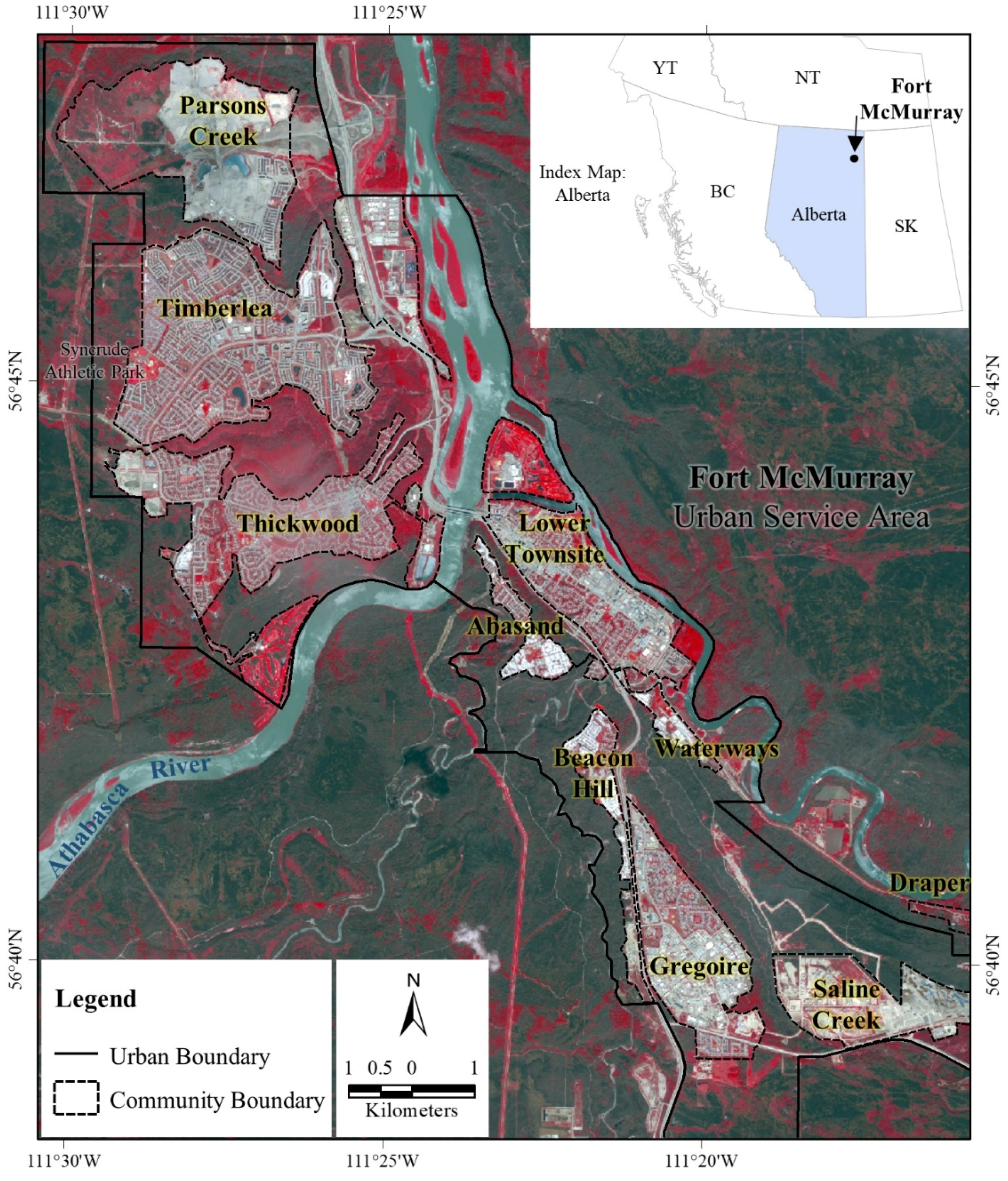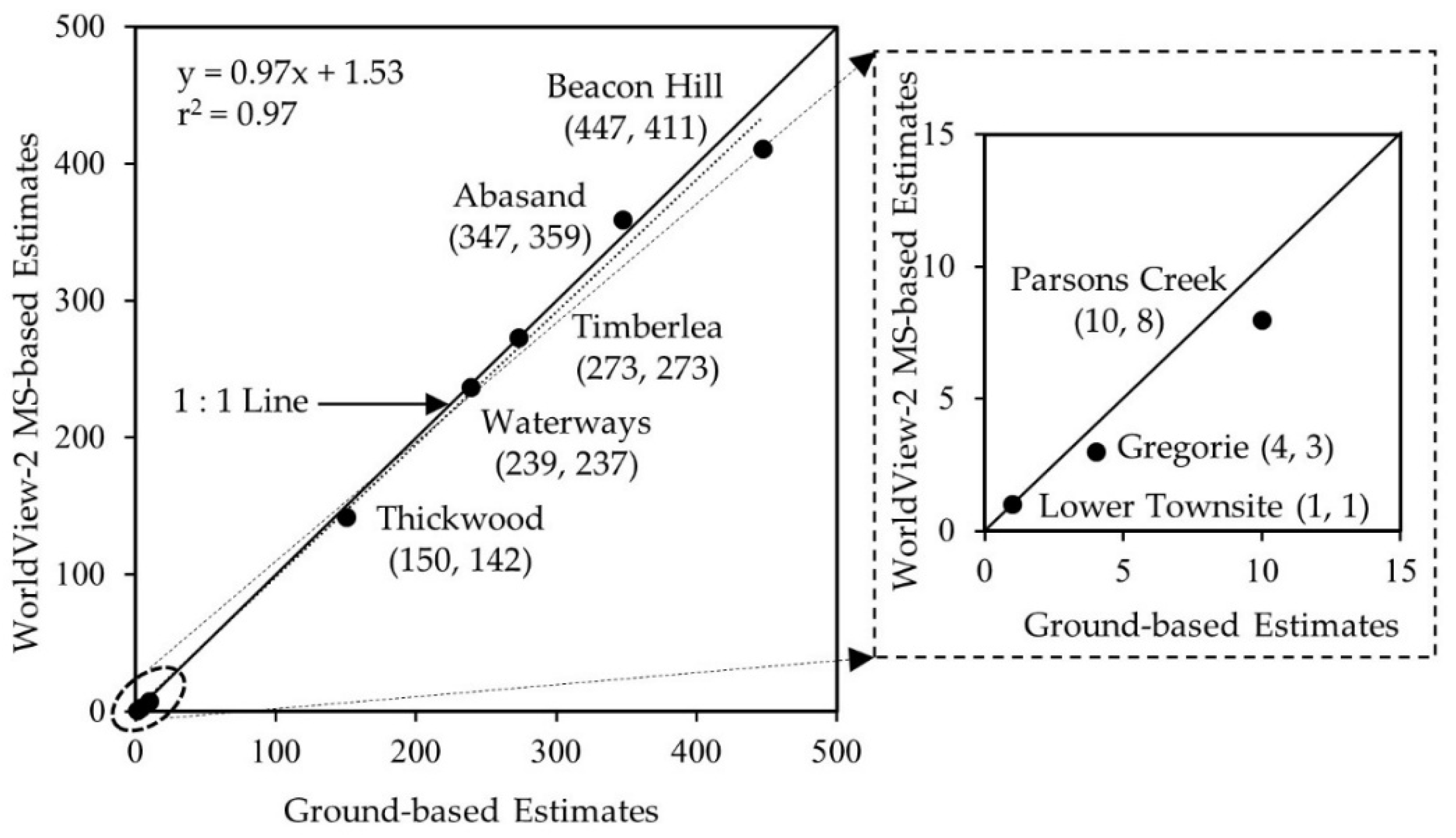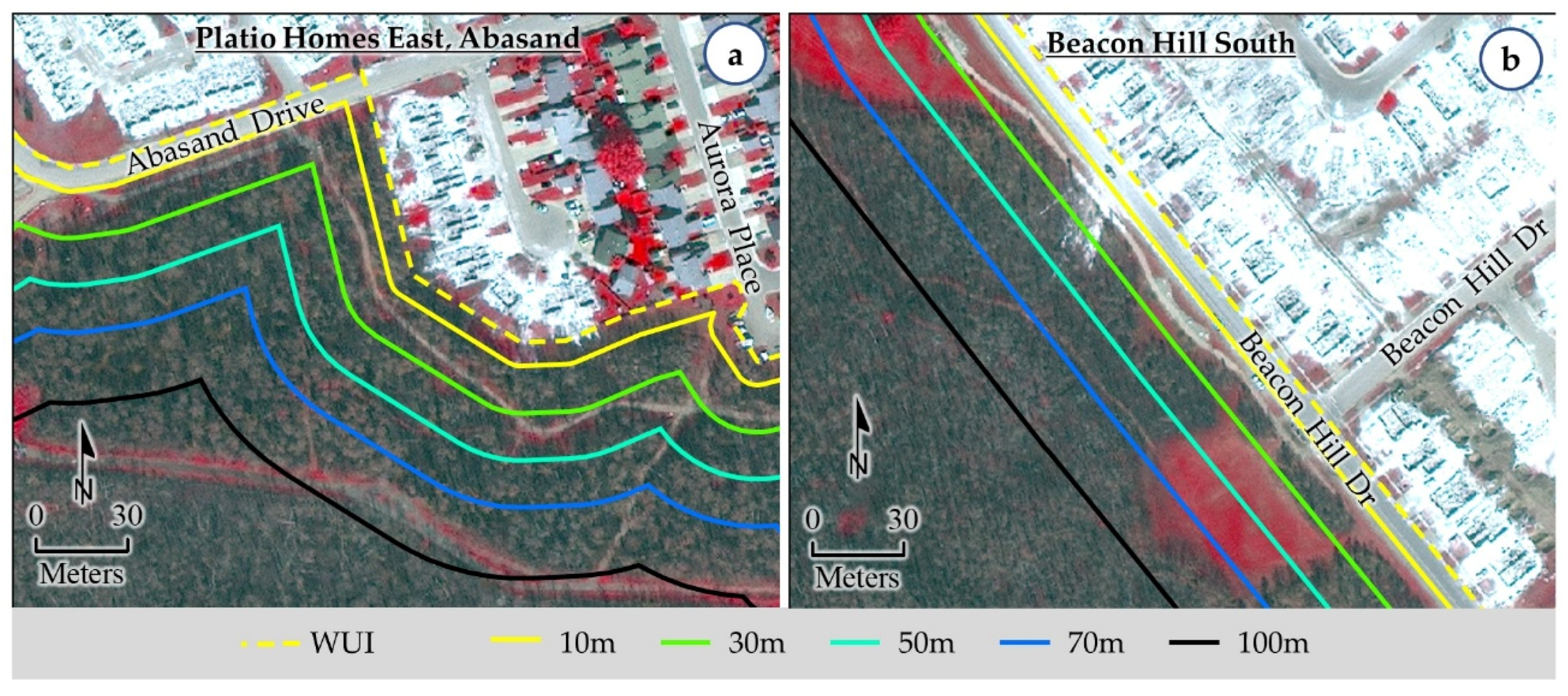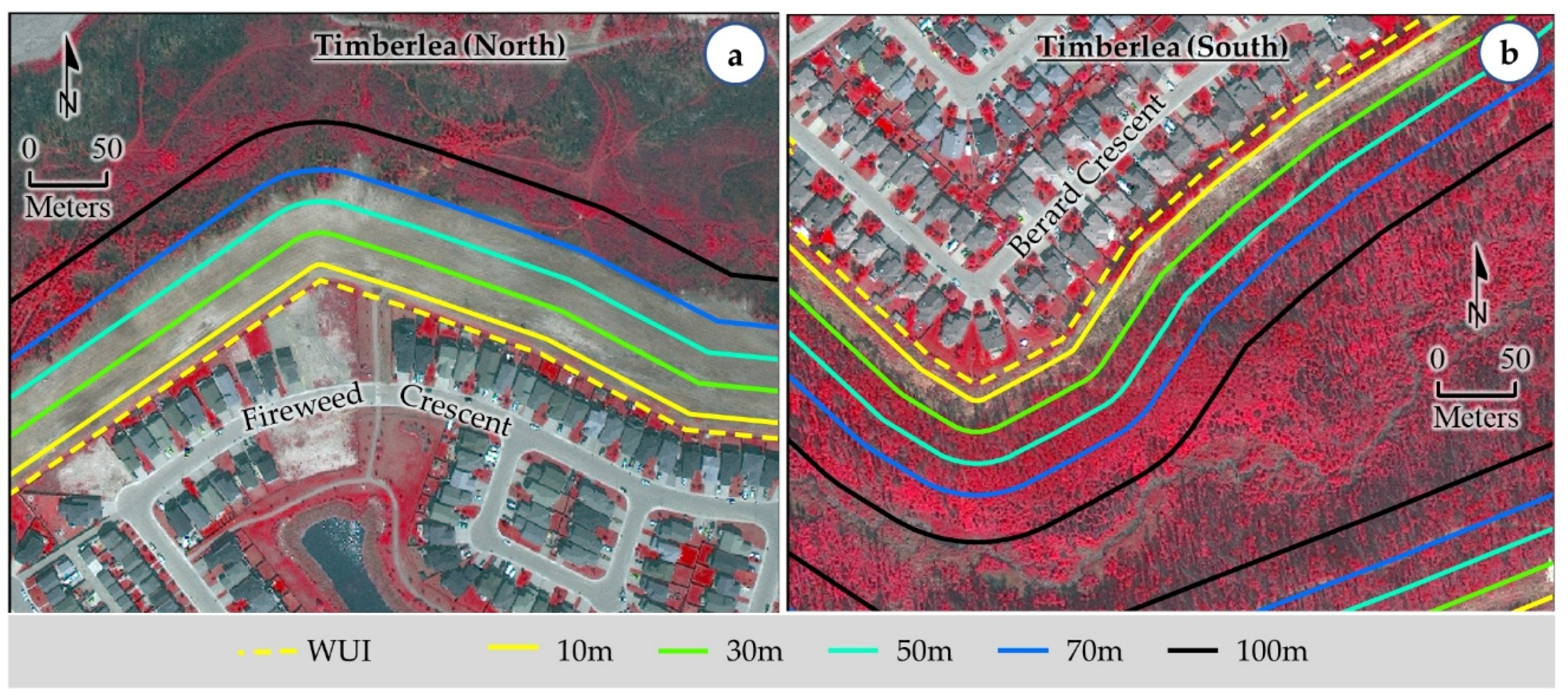Remote Sensing of Wildland Fire-Induced Risk Assessment at the Community Level
Abstract
:1. Introduction
2. Study Area and Data Requirements
2.1. General Description of the Study Area
2.2. Data Requirements
3. Methods
3.1. Pre-Processing of WorldView-2 Images
3.2. Mapping of Structural Damages and Other Features
3.3. Delineating WUI, Risk Zonation and Assessment
4. Results and Discussion
4.1. Structural Damage Assessment
- The satellite image provided only the top view, i.e., rooftops of the structures; which was unable to provide any further information related to damages occurred in the side-walls of the structures. As a result, we failed to identify such damaged structures.
- In the areas with the presence of both large and small houses together (e.g., Beacon Hill North, Beacon Hill South, and Waterways), it would be possible that we counted few small houses as detached garages. Also, note that we didn’t count the damaged detached garages as separate structures, rather than included as part of the main structures.
- In case of the community of Beacon Hill, our count difference was the highest (i.e., ground-based estimates of 447 vs. remote sensing-based estimates of 411). Other studies also reported similar count differences, e.g., Hassan et al. [38]. In addition to the above-mentioned causes, there might have another reason. In the southern part of the community (i.e., Centennial RV Park at around the Latitude 56°40′47″ N and Longitude 111°21′13″ W), we observed an informal arrangement of several damaged structures, which were probably a campground having temporary shelters of tiny and linear houses, trucks, or caravans. In this case, we did not include those small damages in our estimates, rather counted only the two permanent structures located in the area.
- We might have counted some detached garage as separate structure in the dense built-up locations, where the boundaries of the houses were not clearly distinguishable from the satellite image;
- It would be quite possible that some of the town-houses were continuous. However, we were unable to identify such connectivity; thus, interpreted and counted as separate structures; and
- It was quite challenging to comprehend the utilization of the structures from the satellite data, hence a business with multiple structures would possibly be counted as multiple structural damages. Note that one business operation with several structures were considered as one structure in the ground-based estimates (Allison Kennedy-Drake, Performance & Risk Analyst of Recovery Task Force; personal communication).
4.2. Delineation of WUI and Buffers, and Assessment of Potential Risks
4.2.1. Qualitative Assessment
4.2.2. Quantitative Assessment
4.3. Other Considerations
5. Concluding Remarks
Author Contributions
Acknowledgments
Conflicts of Interest
References
- Thomas, D.S.; Butry, D.T. Wildland fires within municipal jurisdictions. J. For. 2012, 110, 34–41. [Google Scholar] [CrossRef]
- Haynes, H.; Garcia, A.; Madsen, R. Wildland/Urban Interface: Fire Department Wildfire Preparedness and Readiness Capabilities; Phase One Report; National Fire Protection Association: Quincy, MA, USA, 2015. [Google Scholar]
- Tedim, F.; Xanthopoulos, G.; Leone, V. Forest fires in Europe: facts and challenges. In Wildfire Hazards, Risks, and Disasters; Elsevier: New York, NY, USA, 2015; pp. 77–99. [Google Scholar] [CrossRef]
- Thomas, D.; Butry, D.; Gilbert, S.; Webb, D.; Fung, J. The Costs and Losses of Wildfires: A Literature Review; NIST Special Publication: Gaithersburg, MD, USA, 2017; Volume 1215, p. 72. [CrossRef]
- Kramer, H.A. A future on fire. Science 2017, 358, 178. [Google Scholar] [CrossRef]
- Wildfires and Your Health. HealthLinkBC. Available online: https://www.healthlinkbc.ca/health-feature/wildfires (accessed on 15 January 2018).
- The Psychological Impact of Wildfires. UBC Faculty of Medicine. Available online: http://www.med.ubc.ca/the-psychological-impact-of-wildfires/ (accessed on 15 January 2018).
- Jones, R.T.; Ribbe, D.P.; Cunningham, P.B.; Weddle, J.D.; Langley, A.K. Psychological impact of fire disaster on children and their parents. Behav. Modif. 2002, 26, 163–186. [Google Scholar] [CrossRef] [PubMed]
- Natural Resources Canada: Wildland Fire Evacuations. Available online: http://www.nrcan.gc.ca/forests/climate-change/forest-change/17787 (accessed on 8 November 2017).
- Alberta Emergency Management Agency. Alberta Wildland/Urban Interface Fires: A Guide for Municipal Directors of Emergency Management and Consequence Management Officers; Government of Alberta: Edmonton, AB, Canada, 2015.
- McIntyre, J. Moving Forward: The Economic Impact of Rebuilding the Wood Buffalo Region’s Economy; The Conference Board of Canada: Ottawa, ON, Canada, 2017. [Google Scholar]
- KPMG. May 2016 Wood Buffalo Wildfire: Post-Incident Assessment Report, Final Report; KPMG LLP: Zurich, Switzerland, 2017. [Google Scholar]
- Beverly, J.L.; Bothwell, P. Wildfire evacuations in Canada 1980–2007. Nat. Hazards 2011, 59, 571–596. [Google Scholar] [CrossRef]
- Whitman, E.; Rapaport, E.; Sherren, K. Modeling fire susceptibility to delineate wildland-urban interface for municipal-scale fire risk management. Environ. Manag. 2013, 52, 1427–1439. [Google Scholar] [CrossRef] [PubMed]
- Stewart, S.I.; Radeloff, V.C.; Hammer, R.B.; Hawbaker, T.J. Defining the wildland—Urban interface. J. For. 2007, 105, 201–207. [Google Scholar]
- Modugno, S.; Balzter, H.; Cole, B.; Borrelli, P. Mapping regional patterns of large forest fires in Wildland-Urban Interface areas in Europe. J. Environ. Manag. 2016, 172, 112–126. [Google Scholar] [CrossRef] [PubMed]
- Radeloff, V.C.; Hammer, R.B.; Stewart, S.I.; Fried, J.S.; Holcomb, S.S.; McKeefry, J.F. The wildland-urban interface in the United States. Ecol. Appl. 2005, 15, 799–805. [Google Scholar] [CrossRef]
- Theobald, D.M.; Romme, W.H. Expansion of the US wildland-urban interface. Landsc. Urban Plan. 2007, 83, 340–354. [Google Scholar] [CrossRef]
- Johnston, L.M.; Flannigan, M.D. Mapping Canadian wildland fire interface areas. Int. J. Wildland Fire 2018, 27, 1–14. [Google Scholar] [CrossRef]
- Sawaya, K. Extending satellite remote sensing to local scales: Land and water resource monitoring using high-resolution imagery. Remote Sens. Environ. 2003, 88, 144–156. [Google Scholar] [CrossRef]
- Syphard, A.D.; Massada, A.B.; Butsic, V.; Keeley, J.E. Land Use Planning and Wildfire: Development Policies Influence Future Probability of Housing Loss. PLoS ONE 2013, 8, e71708. [Google Scholar] [CrossRef] [PubMed]
- Regional Municipality of Wood Buffalo: Fire Assessment Tool. Available online: http://firemap.rmwb.ca/ (accessed on 16 November 2017).
- Galarreta, J.F.; Kerle, N.; Gerke, M. UAV-based urban structural damage assessment using object-based image analysis and semantic reasoning. Nat. Hazards Earth Syst. Sci. 2015, 15, 1087–1101. [Google Scholar] [CrossRef]
- Pham, T.-T.-H.; Apparicio, P.; Gomez, C.; Weber, C.; Mathon, D. Towards a rapid automatic detection of building damage using remote sensing for disaster management. Disaster Prev. Manag. 2014, 23, 53–66. [Google Scholar] [CrossRef]
- United Nations High Commissioner for Refugees: Destroyed Areas in Buthidaung, Maungdaw, and Rathedaung Townships of Rakhine State in Myanmar. Available online: http://www.unitar.org/unosat/node/44/2727?utm_source=unosat-unitar&utm_medium=rss&utm_campaign=maps (accessed on 17 November 2017).
- Ehrlich, D.; Guo, H.D.; Molch, K.; Ma, J.W.; Pesaresi, M. Identifying damage caused by the 2008 Wenchuan earthquake from VHR remote sensing data. Int. J. Digit. Earth 2009, 2, 309–326. [Google Scholar] [CrossRef]
- Platt, R.V. Wildfire hazard in the home ignition zone: An object-oriented analysis integrating LiDAR and VHR satellite imagery. Appl. Geogr. 2014, 51, 108–117. [Google Scholar] [CrossRef]
- Statistics Canada: Census Profile, 2016 Census. Available online: http://www12.statcan.gc.ca/census-recensement/2016/dp-pd/prof/details/page.cfm?Lang=E&Geo1=POPC&Code1=0292&Geo2=PR&Code2=47&Data=Count&SearchText=FortMcMurray&SearchType=Begins&SearchPR=01&B1=All&wbdisable=true (accessed on 21 November 2017).
- Rahaman, K.R.; Hassan, Q.K. Quantification of local warming trend: A remote sensing-based approach. PLoS ONE 2017, 12, 1–18. [Google Scholar] [CrossRef] [PubMed]
- Papineau, J.W.; Deacon, L. Fort McMurray and the Canadian oil sands: Local coverage of national importance. Environ. Commun. 2017, 11, 593–608. [Google Scholar] [CrossRef]
- Regional Municipality of Wood Buffalo. Envision Wood Buffalo Towards 250k: Wood Buffalo—Where We Are Today; Regional Municipality of Wood Buffalo: Fort McMurray, AB, Canada, 2008. [Google Scholar]
- Environment Canada: Canadian Climate Normals 1981–2010 Station Data. Available online: http://climate.weather.gc.ca/climate_normals/results_1981_2010_e.html?stnID=367&autofwd=1 (accessed on 22 November 2017).
- Natural Regions Committee. Natural Regions and Subregions of Alberta; Downing, D.J., Pettapiece, W.W., Eds.; Government of Alberta: Edmonton, AB, Canada, 2006.
- Girardin, M.P.; Wotton, B.M. Summer moisture and wildfire risks across Canada. J. Appl. Meteorol. Climatol. 2009, 48, 517–533. [Google Scholar] [CrossRef]
- Stirling, M. Fort McMurray wildfire 2016: Conflating human-caused wildfires with human-caused global warming. Soc. Sci. Res. Netw. 2017. [Google Scholar] [CrossRef]
- Alberta Wildfire: Historical Wildfire Database. Available online: http://wildfire.alberta.ca/resources/historical-data/historical-wildfire-database.aspx (accessed on 22 November 2017).
- Satellite Imaging Corporation: WorldView-2 Satellite Sensor. Available online: https://www.satimagingcorp.com/satellite-sensors/worldview-2/ (accessed on 21 November 2017).
- Hassan, Q.K.; Ahmed, M.R.; Rahaman, K.R. Remote Sensing of Wildland Fire-Induced Risk Assessment; Report; National Fire Information Database (NFID) Project: Vancouver, BC, Canada, 2017; Available online: http://hdl.handle.net/1880/106635 (accessed on 14 May 2018).
- Regional Municipality of Wood Buffalo: Community Street Maps. Available online: https://www.rmwb.ca/living/Maps/Community-Street-Maps.htm (accessed on 6 November 2017).
- Regional Municipality of Wood Buffalo: Municipal Development Plan. Available online: http://www.rmwb.ca/Assets/MDP+Assets/Draft_MDP/Final+MDP.pdfopment (accessed on 6 November 2017).
- Alberta Government. FireSmart: Guidebook for Community Protection. A Guidebook for Wildland/Urban Interface Communities; Provincial Forest Fire Centre: Edmonton, AB, Canada, 2013; ISBN 9781460107805.
- Chávez, P.S.J. Image-based atmospheric corrections—Revisited and improved. Photogramm. Eng. Remote Sens. 1996, 62, 1025–1036. [Google Scholar]
- Hoang, T.C.; O’Leary, M.J.; Fotedar, R.K. Remote-sensed mapping of Sargassum spp. distribution around Rottnest Island, Western Australia, using high-spatial resolution WorldView-2 satellite data. J. Coast. Res. 2016, 322, 1310–1321. [Google Scholar] [CrossRef]
- Nazeer, M.; Nichol, J.E.; Yung, Y.K. Evaluation of atmospheric correction models and Landsat surface reflectance product in an urban coastal environment. Int. J. Remote Sens. 2014, 35, 6271–6291. [Google Scholar] [CrossRef]
- Lillesand, T.M.; Kiefer, R.W.; Chipman, J.W. Remote Sensing and Image Interpretation, 5th ed.; John Wiley & Sons Inc.: New York, NY, USA, 2004; ISBN 0470052457. [Google Scholar]
- Ashraf, S.; Brabyn, L.; Hicks, B.J. Introducing contrast and luminance normalisation to improve the quality of subtractive resolution merge technique. Int. J. Image Data Fusion 2013, 4, 230–251. [Google Scholar] [CrossRef]
- Zhang, Y.; Mishra, R. A review and comparison of commercially available pan-sharpening techniques for high resolution satellite image fusion. In Proceedings of the 2012 IEEE International Conference on Geoscience and Remote Sensing Symposium (IGARSS), Munich, Germany, 22–27 July 2012; pp. 182–185. [Google Scholar]
- Jovanović, D.; Govedarica, M.; Sabo, F.; Važić, R.; Popović, D. Impact analysis of pansharpening Landsat ETM+, Landsat OLI, WorldView-2, and Ikonos images on vegetation indices. In Proceedings of the Fourth International Conference on Remote Sensing and Geoinformation of the Environment (RSCy2016), Paphos, Cyprus, 12 August 2016; International Society for Optics and Photonics: Bellingham, WA, USA, 2016; Volume 9688, p. 968814. [Google Scholar]
- Rahaman, K.R.; Hassan, Q.K.; Ahmed, M.R. Pan-sharpening of Landsat-8 images and its application in calculating vegetation greenness and canopy water contents. ISPRS Int. J. Geo-Inf. 2017, 6, 168. [Google Scholar] [CrossRef]
- Chavez, P.S. Comparison of spatial variability in visible and near-infrared spectral images. Photogramm. Eng. Remote Sens. 1992, 58, 957–964. [Google Scholar]
- Johnson, B. Effects of pansharpening on vegetation indices. ISPRS Int. J. Geo-Inf. 2014, 3, 507–522. [Google Scholar] [CrossRef]
- Caggiano, M.D.; Tinkham, W.T.; Hoffman, C.; Cheng, A.S.; Hawbaker, T.J. High resolution mapping of development in the wildland-urban interface using object based image extraction. Heliyon 2016, 2, e00174. [Google Scholar] [CrossRef] [PubMed]
- Lowell, K.; Shamir, R.; Siqueira, A.; White, J.; O’Connor, A.; Butcher, G.; Garvey, M.; Niven, M. Assessing the capabilities of geospatial data to map built structures and evaluate their bushfire threat. Int. J. Wildland Fire 2009, 18, 1010–1020. [Google Scholar] [CrossRef]
- The BC Forest Service. The Home Owners FireSmart Manual: Protect Your Home from Wildfire (B.C. Edition); The BC Forest Service, Protection Branch: Victoria, BC, Canada, 2003.
- Westhaver, A. Why Some Homes Survived: Learning from the Fort McMurray Wildland/Urban Interface Fire Disaster. Available online: https://www.iclr.org/images/Westhaver_Fort_McMurray_Final_2017.pdf (accessed on 6 November 2017).
- Akther, M.S.; Hassan, Q.K. Remote sensing-based assessment of fire danger conditions over boreal forest. IEEE J. Sel. Top. Appl. Earth Obs. Remote Sens. 2011, 4, 992–999. [Google Scholar] [CrossRef]
- Chowdhury, E.H.; Hassan, Q.K. Use of remote sensing-derived variables in developing a forest fire danger forecasting system. Nat. Hazards 2013, 67, 321–334. [Google Scholar] [CrossRef]
- Chowdhury, E.H.; Hassan, Q.K. Operational perspective of remote sensing-based forest fire danger forecasting systems. ISPRS J. Photogramm. Remote Sens. 2015, 104, 224–236. [Google Scholar] [CrossRef]
- Chowdhury, E.H.; Hassan, Q.K. Development of a new daily-scale forest fire forecasting system using remote sensing data. Remote Sens. 2015, 7, 2431–2448. [Google Scholar] [CrossRef]
- Abdollahi, M.; Hassan, Q.K.; Chowdhury, E.H.; Gupta, A. Exploring the relationships between topographical elements and forest fire occurrences in Alberta, Canada. In Remote Sensing of Hydro-Meteorological Hazards; Petropoulos, G., Islam, T., Eds.; CRC Press: Boca Raton, FL, USA, 2017; Chapter 13. [Google Scholar]







| Risk Category | Buffer Zone (m) | Area under Potential Risk (%) | Area of Burned Forest/Grass (i.e., Fuels Adjacent to the Structures) (%) | Tree Standing during HRF (%) | ||
|---|---|---|---|---|---|---|
| (A) | (B) | (C) | (D) | |||
| Damaged | Non-Damaged | Total | (A + C) | |||
| (B1) | (B2) | (B1 + B2) | ||||
| Extreme Risk | WUI to 10 | 10.35 | 1.43 | 0.84 | 2.28 | 12.62 |
| Very High Risk | 10 to 30 | 11.34 | 5.82 | 0.12 | 5.94 | 17.28 |
| High Risk | 30 to 50 | 18.18 | 8.10 | 2.24 | 10.34 | 28.52 |
| Medium Risk | 50 to 70 | 22.40 | 9.12 | 5.30 | 14.42 | 36.83 |
| Low Risk | 70 to 100 | 26.07 | 13.47 | 6.92 | 20.39 | 46.46 |
| Total | 37.94 | 15.42 | ||||
© 2018 by the authors. Licensee MDPI, Basel, Switzerland. This article is an open access article distributed under the terms and conditions of the Creative Commons Attribution (CC BY) license (http://creativecommons.org/licenses/by/4.0/).
Share and Cite
Ahmed, M.R.; Rahaman, K.R.; Hassan, Q.K. Remote Sensing of Wildland Fire-Induced Risk Assessment at the Community Level. Sensors 2018, 18, 1570. https://doi.org/10.3390/s18051570
Ahmed MR, Rahaman KR, Hassan QK. Remote Sensing of Wildland Fire-Induced Risk Assessment at the Community Level. Sensors. 2018; 18(5):1570. https://doi.org/10.3390/s18051570
Chicago/Turabian StyleAhmed, M. Razu, Khan Rubayet Rahaman, and Quazi K. Hassan. 2018. "Remote Sensing of Wildland Fire-Induced Risk Assessment at the Community Level" Sensors 18, no. 5: 1570. https://doi.org/10.3390/s18051570






